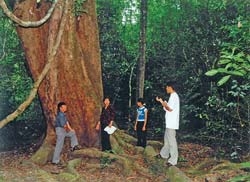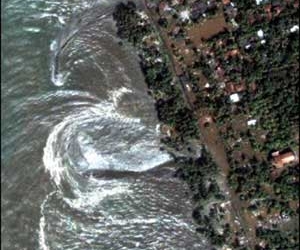Aokigahara is a dense forest located at the base of Mount Fuji in Japan, notorious for the high number of suicides that have occurred in the area.
Despite its many mysteries, it remains one of the most visited tourist destinations in Japan.
Some believe that Aokigahara is haunted, filled with spirits from Japanese mythology. Others suggest that the forest is a site of mystical activities due to the high death toll, thus it is often referred to as the “Suicide Forest.”
Aokigahara is also known as Jukai (meaning “sea of trees”), a forest on the northwest slope of Mount Fuji on Honshu Island. This forest is built on a hardened lava bed spanning 30 square kilometers, originating from the last major eruption of Mount Fuji in 864 AD.
The western edge of Aokigahara, where several ice caves form in winter, is a popular site for sightseeing and tourism. Some parts of Aokigahara are densely wooded, and the porous lava in the forest absorbs sound, creating an overwhelming sense of solitude for visitors.

Aokigahara is also known as “the Suicide Forest.”
Aokigahara is a renowned site for suicides in Japan and is an attractive destination for horror film enthusiasts. The forest is situated in the northwest of Mount Fuji, within Yamanashi Prefecture. Those who choose the fifth station to conquer Mount Fuji will have the opportunity to pass through this famous forest.
Until 1988, around 30 people were reported to have committed suicide in this forest each year. A total of 78 bodies were discovered in 2002, 105 in 2003, and by 2010, it was estimated that over 200 individuals had taken their lives here, with 54 succeeding.
In March each year, coinciding with the end of the fiscal year in Japan, the suicide rate in the country peaks. The most common methods of suicide are hanging or overdose.

Some parts of Aokigahara are densely wooded, and the porous lava in the forest.
Japan has a very high annual suicide rate, averaging 70 suicides (though primarily unsuccessful) each day in 2014. The vast majority, approximately 71%, are men, and this is the leading cause of death among males aged 20 to 44 in the country.
Japan has a history of ritual suicides for various reasons, a practice that was common in the feudal military. The most notable example is the samurai who committed seppuku to avoid capture or disgrace, and during World War II, soldiers also took their lives to preserve honor or spare their families from shame following failure on the battlefield. Samurai would cut their stomachs with a sword, believing this would free their spirit and prevent a disgraceful death at the hands of the enemy.

. The forest contains an extremely high iron content and is damp.
This is a dense forest formed by volcanic lava from 864 AD. The forest has an extremely high iron content and is damp, making it very cold and eerie. If you venture about 2 kilometers deep, you will feel completely cut off from the outside world. Additionally, GPS devices and compasses almost cease to function.
Since the 1990s, Japan has seen an increase in suicides due to unemployment caused by economic recession, depression, or social pressure. In 1998, after a 34.7% rise in suicides compared to the previous year, the Japanese government increased funding to address these causes and assist individuals recovering from failed suicide attempts.
At the entrance of the main trail leading into Aokigahara, there is a sign urging those with suicidal thoughts to consider their families and seek help from suicide prevention organizations.

The sign reads: “Think again about the life you have been given, your parents, siblings, and children. Don’t suffer alone, reach out to someone. (And the hotline number).”
Aokigahara is a very dense forest with numerous caves, making it popular among tourists. The forest is so thick that it can block out all other sounds except for the natural sounds of the forest. To avoid getting lost, most hikers and tourists use tape to mark their paths so they can find their way back if they stray.

The forest is so thick that it can block out all other sounds.
The forest is filled with giant ancient trees and uneven roots. The towering trees obscure sunlight, making the place even colder and darker, even during the day. For this reason, Aokigahara is also called Jukai, meaning “sea of trees.”
According to Japanese legend, this forest is home to yūrei: the spirits of the deceased from Japanese mythology.
In recent years, Aokigahara has gained international fame as “the Suicide Forest,” one of the most popular suicide locations in the world.
Aokigahara has also been referenced in various media, including anime and manga, films, literature, music, and video games.





















































